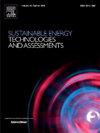通过太阳能和风能集成及自动控制实现可持续海水淡化:实验研究
IF 7.1
2区 工程技术
Q1 ENERGY & FUELS
Sustainable Energy Technologies and Assessments
Pub Date : 2024-09-24
DOI:10.1016/j.seta.2024.103990
引用次数: 0
摘要
该研究调查了通过风力涡轮机和光伏(PV)板驱动的混合太阳能蒸馏器/反渗透(RO)蒸馏系统的效率。该系统采用了一套自控系统,用于实时管理系统的运行,确保系统性能稳定。光伏板配有自动冷却系统。系统中的太阳能蒸馏器配有预热和覆盖冷却机制,以最大限度地提高淡水产量。此外,反渗透装置可持续获得光伏和太阳能蒸馏器冷却产生的预热水。这种创新的系统设计可同时利用太阳能和风能,风力涡轮机可持续发电,确保海水淡化过程不间断运行。结果表明,光伏电池板冷却系统的实施大大提高了效率。此外,采用预热和覆盖冷却的太阳能蒸馏器显示出卓越的淡水生产率,比传统系统显著提高了 21.89%,日产水量从 3.06 升/平方米增加到 3.73 升/平方米。同样,反渗透-光伏系统的日产量从 73.62 升/平方米显著增加到 86.98 升/平方米,比能耗从 2.35 千瓦时/立方米减少到 1.99 千瓦时/立方米。反渗透-风力系统的日产量有所提高,从 198.04 升/平方米上升到 210.92 升/平方米,比能耗从 2.62 千瓦时/立方米下降到 2.46 千瓦时/立方米。本文章由计算机程序翻译,如有差异,请以英文原文为准。
Sustainable seawater desalination through solar and wind energy integration with automated control: Experimental investigation
The study investigates the efficiency of a hybrid solar still/reverse osmosis (RO) distillation system that is driven via wind turbines and photovoltaic (PV) panels. A self-automated control system was implemented to manage the system’s operations in real-time, ensuring robust performance. The PV panels are equipped with an automated cooling system. Solar stills are incorporated into the system with preheating and cover cooling mechanisms to maximize freshwater production. Furthermore, the RO unit is continuously fed by preheated water resulting from the PV and solar still cooling. This innovative system design allows for the utilization of both solar and wind energy, with wind turbines providing continuous power generation to ensure uninterrupted operation of the desalination process. Results show that implementing a cooling system for PV panels led to a significant improvement in efficiency. Furthermore, solar stills with preheating and cover cooling demonstrated superior freshwater production rates, achieving a remarkable 21.89 % increase over conventional systems, with daily water production increasing from 3.06 to 3.73 L/m2. Similarly, RO-PV sees a notable increase in daily yield from 73.62 to 86.98 L/m2, accompanied by a reduction in specific energy consumption from 2.35 to 1.99 kWh/m3. The RO-wind system exhibits enhanced daily yield, rising from 198.04 to 210.92 L/m2 and decreasing specific energy consumption from 2.62 to 2.46 kWh/m3.
求助全文
通过发布文献求助,成功后即可免费获取论文全文。
去求助
来源期刊

Sustainable Energy Technologies and Assessments
Energy-Renewable Energy, Sustainability and the Environment
CiteScore
12.70
自引率
12.50%
发文量
1091
期刊介绍:
Encouraging a transition to a sustainable energy future is imperative for our world. Technologies that enable this shift in various sectors like transportation, heating, and power systems are of utmost importance. Sustainable Energy Technologies and Assessments welcomes papers focusing on a range of aspects and levels of technological advancements in energy generation and utilization. The aim is to reduce the negative environmental impact associated with energy production and consumption, spanning from laboratory experiments to real-world applications in the commercial sector.
 求助内容:
求助内容: 应助结果提醒方式:
应助结果提醒方式:


